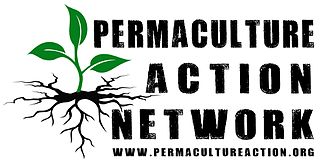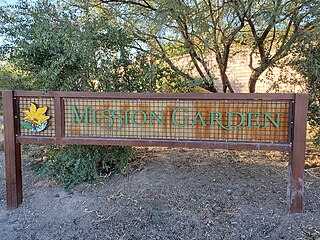
In ecology, an oasis is a fertile area of a desert or semi-desert environment that sustains plant life and provides habitat for animals. Surface water and land may be present, or water may only be accessible from wells or underground channels created by humans. In geography, an oasis may be a current or past rest stop on a transportation route, or less-than-verdant location that nonetheless provides access to underground water through deep wells created and maintained by humans.

The Tohono Oʼodham are a Native American people of the Sonoran Desert, residing primarily in the U.S. state of Arizona and the northern Mexican state of Sonora. The United States federally recognized tribe is the Tohono Oʼodham Nation.

Permaculture is an approach to land management and settlement design that adopts arrangements observed in flourishing natural ecosystems. It includes a set of design principles derived using whole-systems thinking. It applies these principles in fields such as regenerative agriculture, town planning, rewilding, and community resilience. The term was coined in 1978 by Bill Mollison and David Holmgren, who formulated the concept in opposition to modern industrialized methods, instead adopting a more traditional or "natural" approach to agriculture.

Bruce Charles "Bill" Mollison was an Australian researcher, author, scientist, teacher and biologist. In 1981, he was awarded the Right Livelihood Award "for developing and promoting the theory and practice of permaculture".

Rainwater harvesting (RWH) is the collection and storage of rain, rather than allowing it to run off. Rainwater is collected from a roof like surface and redirected to a tank, cistern, deep pit, aquifer, or a reservoir with percolation, so that it seeps down and restores the ground water. Dew and fog can also be collected with nets or other tools. Rainwater harvesting differs from stormwater harvesting as the runoff is typically collected from roofs and other area surfaces for storage and subsequent reuse. Its uses include watering gardens, livestock, irrigation, domestic use with proper treatment, and domestic heating. The harvested water can also be committed to longer-term storage or groundwater recharge.

A swale is a shady spot, or a sunken or marshy place. In US usage in particular, it is a shallow channel with gently sloping sides. Such a swale may be either natural or human-made. Artificial swales are often infiltration basins, designed to manage water runoff, filter pollutants, and increase rainwater infiltration. Bioswales are swales that involve the inclusion of plants or vegetation in their construction, specifically.
Gary Paul Nabhan is an agricultural ecologist, Ethnobotanist, Ecumenical Franciscan Brother, and author whose work has focused primarily on the plants and cultures of the desert Southwest. He is considered a pioneer in the local food movement and the heirloom seed saving movement.

A rainwater tank is a water tank used to collect and store rain water runoff, typically from rooftops via pipes. Rainwater tanks are devices for collecting and maintaining harvested rain. A rainwater catchment or collection system can yield 2,358 litres (623 US gal) of water from 2.54 cm (1.00 in) of rain on a 92.9 m2 (1,000 sq ft) roof.

Desert farming is the practice of developing agriculture in deserts. As agriculture depends upon irrigation and water supply, farming in arid regions where water is scarce is a challenge. However, desert farming has been practiced by humans for thousands of years. In the Negev, there is evidence to suggest agriculture as far back as 5000 BC. Today, the Imperial Valley in southern California, Australia, Saudi Arabia, Israel and Palestine are examples of modern desert agriculture. Water efficiency has been important to the growth of desert agriculture. Water reuse, desalination, and drip irrigation are all modern ways that regions and countries have expanded their agriculture despite being in an arid climate.

Prosopis velutina, commonly known as velvet mesquite, is a small to medium-sized tree. It is a legume adapted to a dry, desert climate. Though considered to be a noxious weed in states outside its natural range, it plays a vital role in the ecology of the Sonoran Desert.

Xeriscaping is the process of landscaping, or gardening, that reduces or eliminates the need for irrigation. It is promoted in regions that do not have accessible, plentiful, or reliable supplies of fresh water and has gained acceptance in other regions as access to irrigation water has become limited, though it is not limited to such climates. Xeriscaping may be an alternative to various types of traditional gardening.

Phoradendron californicum, the desert mistletoe or mesquite mistletoe, is a hemiparasitic plant native to southern California, Nevada, Arizona, Sonora, Sinaloa and Baja California. It can be found in the Mojave and Sonoran Deserts at elevations of up to 1400 m.

A cactarium or cactuario is a garden dedicated to the planting of cacti. While they generally specialize in collecting cacti, they can also include other desert plants such as sabla, agaves or Crassulaceae, although this would better be termed "xeriscaping".

The agricultural practices of the Native Americans inhabiting the American Southwest, which includes the states of Arizona and New Mexico plus portions of surrounding states and neighboring Mexico, are influenced by the low levels of precipitation in the region. Irrigation and several techniques of water harvesting and conservation were essential for successful agriculture. To take advantage of limited water, the southwestern Native Americans utilized irrigation canals, terraces (trincheras), rock mulches, and floodplain cultivation. Success in agriculture enabled some Native Americans to live in communities which numbered in the thousands as compared to their former lives as hunter-gatherers in which their bands numbered only a few dozen.

Permaculture Action Network is an organization that mobilizes concert-goers and festival-attendees to come out to "Permaculture Action Days," one day events where participants take direct action to build permaculture systems in the cities where they live. Past projects that the Permaculture Action Network has implemented include urban farms, community gardens, public food forests, earthen structures, rainwater catchment systems, greenhouses, and school orchards.
Melesse Temesgen is an Ethiopian agricultural engineer, hydrologist and businessman. He was born on 7 July 1964 in Gojjam, Ethiopia. He is the CEO of Aybar Engineering PLC.
Soil carbon sponge is porous, well-aggregated soil in good health, better able to absorb and retain water. Australian microbiologist and climatologist, Walter Jehne, articulated the concept of the soil carbon sponge in his 2017 paper, Regenerate Earth, connecting soil carbon with a restored water cycle able induce planetary cooling through evaporative cooling and higher reflectance of denser green vegetation. Cooling from increased cloud formation is another benefit of soil regeneration anticipated by Jehne.

Rainwater harvesting in the Sahel is a combination of "indigenous and innovative" agricultural strategies that "plant the rain" and reduce evaporation, so that crops have access to soil moisture for the longest possible period of time. In the resource-poor drylands of the Sahel region of Africa, irrigation systems and chemical fertilizers are often prohibitively expensive and thus uncommon: so increasing or maintaining crop yields in the face of climate change depends on augmenting the region's extant rainfed agriculture systems to "increase water storage within the soil and replenish soil nutrients." Rainwater harvesting is a form of agricultural water management. Rainwater harvesting is most effective when combined with systems for soil regeneration and organic-matter management.

Mission Garden is a living agricultural museum near Sentinel Peak in Tucson, Arizona. Its adobe walls enclose four acres of heritage crops and heirloom trees. These plants represent people who have lived in the Sonoran Desert over the past 4,000 years. They include Hohokam, Tohono O’odham, Spanish colonials and other Europeans, Mexicans, Chinese, and people of African descent. As a result, Mission Garden grows crops that originated in many areas of the world. Some of these crops are listed in the Ark of Taste's catalog of heritage foods. White Sonora wheat and O'odham pink bean exemplify local foods in this catalog.

















